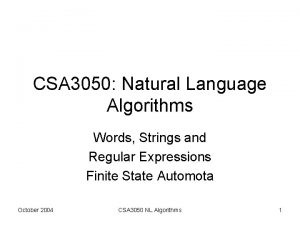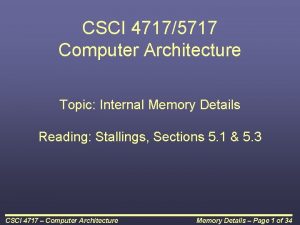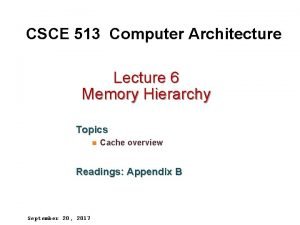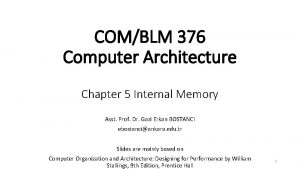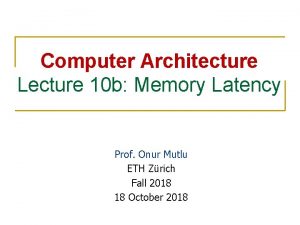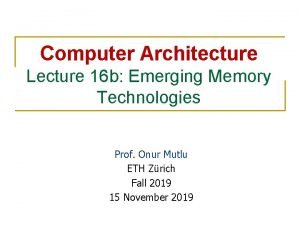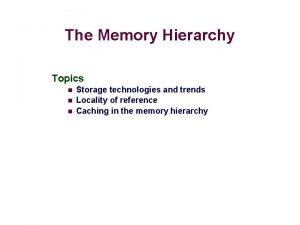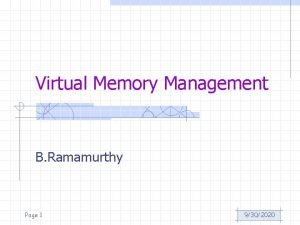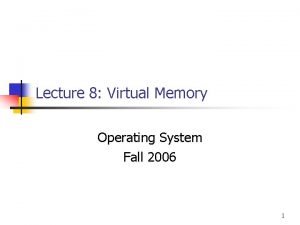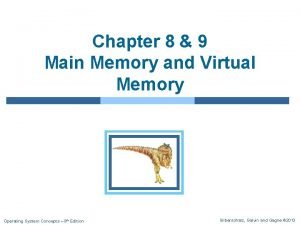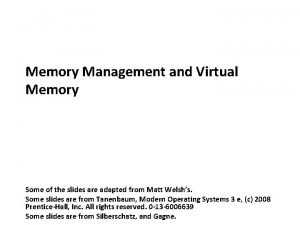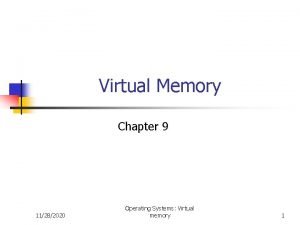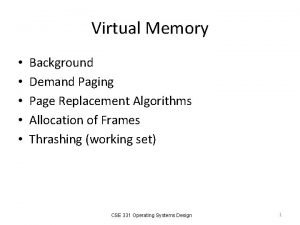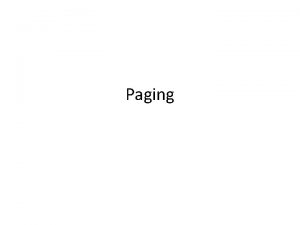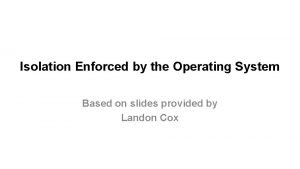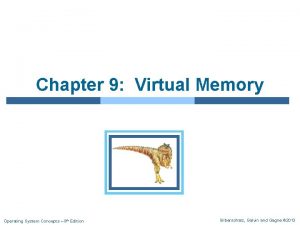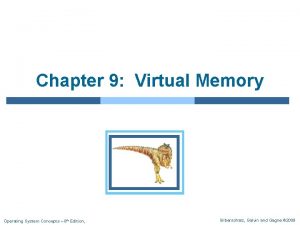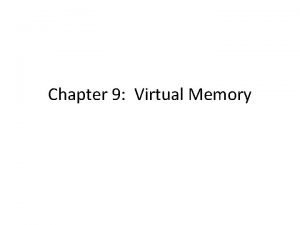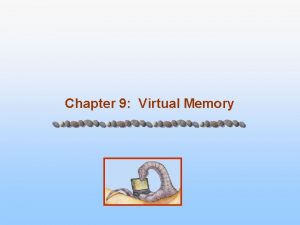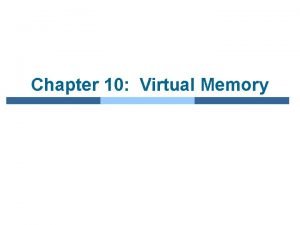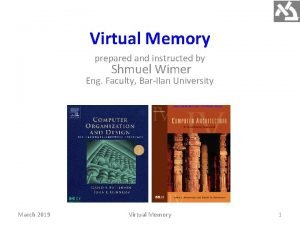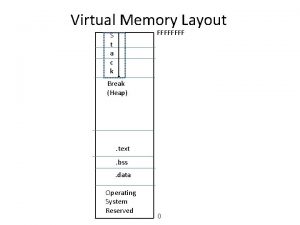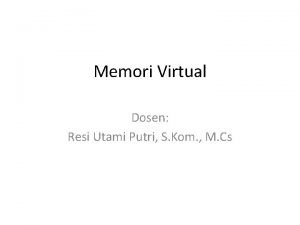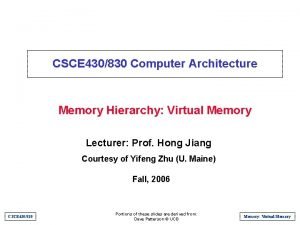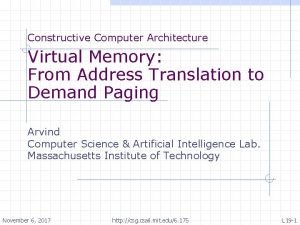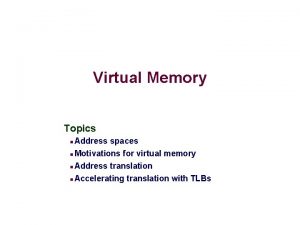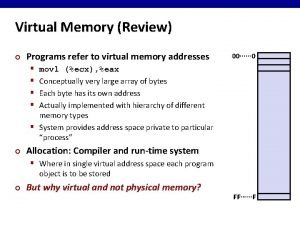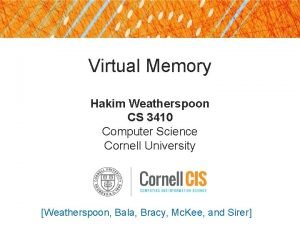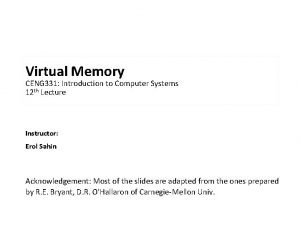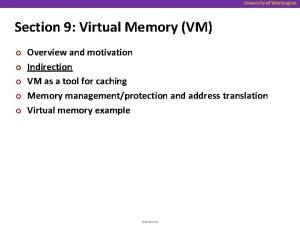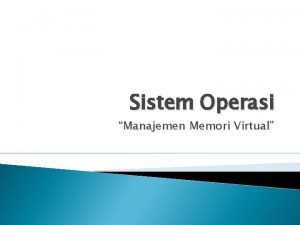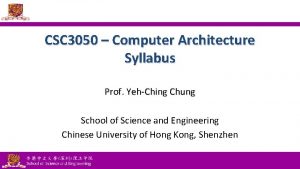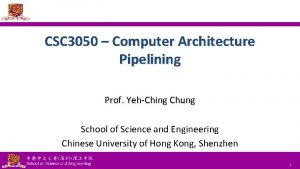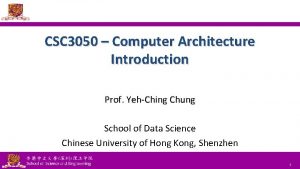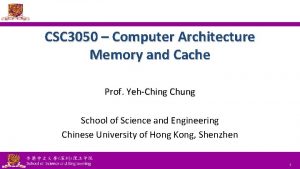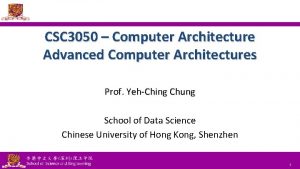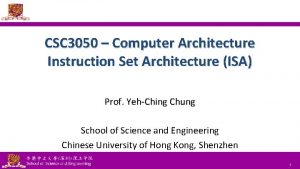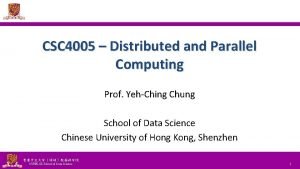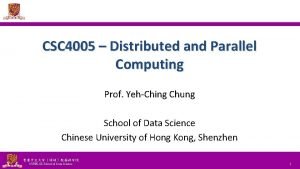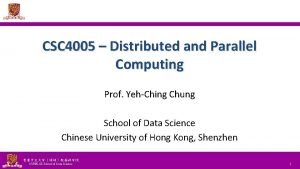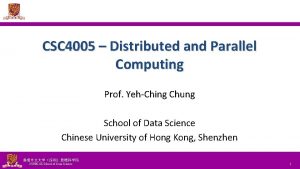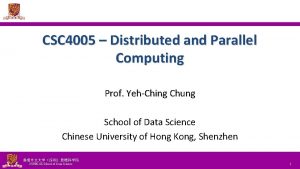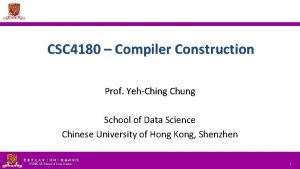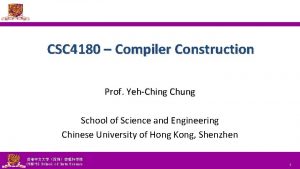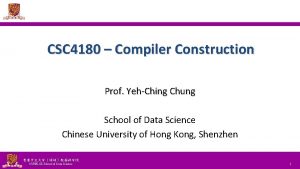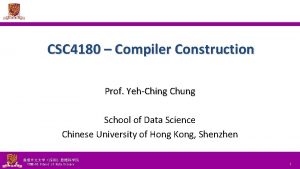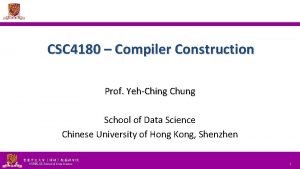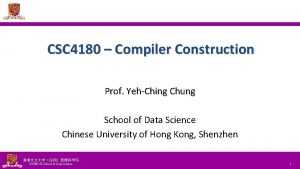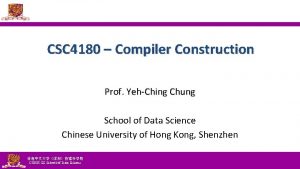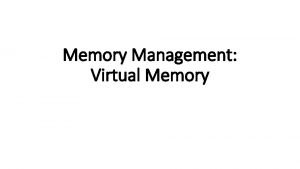CSC 3050 Computer Architecture Virtual Memory Prof YehChing
























































- Slides: 56

CSC 3050 – Computer Architecture Virtual Memory Prof. Yeh-Ching Chung School of Science and Engineering Chinese University of Hong Kong, Shenzhen National Tsing Hua University ® copyright OIA 1

Outline l Virtual memory – Basics – Issues in virtual memory – Handling huge page table – TLB (Translation Lookaside Buffer) – TLB and cache l A common framework for memory hierarchy l Using a Finite State Machine to Control a Simple Cache l Parallelism and Memory Hierarchies: Cache Coherence National Tsing Hua University ® copyright OIA 2

Levels of Memory Hierarchy Registers Instruction Operands Staging Transfer Unit Upper Level faster Programer/Compiler Cache Blocks Cache Controller Memory Pages Operating System Disk Files Tape National Tsing Hua University ® copyright OIA User/Operator Larger Lower Level 3

Virtual Memory disk memory cache register frame National Tsing Hua University ® copyright OIA pages 4

Diagram of Process State new terminated interrupt admitted exit ready I/O or event completion running scheduler dispatch I/O or event waiting National Tsing Hua University ® copyright OIA 5

CPU Scheduler l Select one of the ready processes, and allocates the CPU to it. ready queue I/O National Tsing Hua University ® copyright OIA CPU I/O queue(s) 6

Virtual Memory (1) l Programs share main memory (Multi-programming and I/O) – Program executed in a name space (virtual address space) different from memory space (physical address space) – Each gets a private virtual address space holding its frequently used code and data, starting at address 0, only accessible to itself • Yet, any can run anywhere in physical memory • Virtual memory implements the translation from virtual space to physical space – Every program has lots of memory (> physical memory) – Protected from other programs National Tsing Hua University ® copyright OIA Virtual Address Space 7

Virtual Memory (2) l Use main memory as a “cache” for secondary (disk) storage – Managed jointly by CPU hardware and the operating system (OS) l CPU and OS translate virtual addresses to physical addresses – VM “block” is called page – VM translation “miss” is called page fault National Tsing Hua University ® copyright OIA 8

Virtual Memory (3) National Tsing Hua University ® copyright OIA 9

Outline l Virtual memory – Basics – Issues in virtual memory – Handling huge page table – TLB (Translation Lookaside Buffer) – TLB and cache l A common framework for memory hierarchy l Using a Finite State Machine to Control a Simple Cache l Parallelism and Memory Hierarchies: Cache Coherence National Tsing Hua University ® copyright OIA 10

Basic Issues in Virtual Memory Size of data blocks that are transferred from disk to main memory l Which region of memory to hold the new block => Placement policy l When memory is full, then some regions of memory must be released to make room for the new block => replacement policy l When to fetch missing items from disk? l – Fetch only on a fault => demand load policy register cache memory frame National Tsing Hua University ® copyright OIA disk pages 11

Block Size and Placement Policy l Huge miss penalty – A page fault may take millions of cycles to process – Pages should be fairly large (e. g. , 4 KB) to amortize the high access time • Reducing page faults is important – Fully associative placement => use page table (in memory) to locate pages National Tsing Hua University ® copyright OIA 12

Address Translation l Fixed-size pages (e. g. , 4 K) National Tsing Hua University ® copyright OIA 13

Page Tables l Stores placement information – Page table stored in main memory – Array of page table entries, indexed by virtual page number – Page table register in CPU points to page table in physical memory l If page is present in memory – Page table entry (PTE) stores the physical page number – Plus other status bits (referenced, dirty, …) l If page is not present – PTE can refer to location in swap space on disk National Tsing Hua University ® copyright OIA 15

Page Tables How many memory references for each address translation? All addresses generated by the program are virtual addresses Table located in physical memory National Tsing Hua University ® copyright OIA 16

Page Fault Page hit, proceed normally l Page fault means that page is not in memory l Huge miss penalty l – A page fault may take millions of cycles to process Hardware must detect situation but it cannot remedy the situation l Can handle the faults in software instead of hardware, because handling time is small compared to disk access l – The software can be very smart or complex – The faulting process can be context-switched National Tsing Hua University ® copyright OIA 17

OS Handling Page Faults l Hardware must trap to the operating system so that it can remedy the situation – – l Pick a page to discard (may write it to disk) Load the page in from disk Update the page table Resume to program so HW will retry and succeed! In addition, OS must know where to find the page – Create space on disk for all pages of process (swap space) – Use a data structure to record where each valid page is on disk (may be part of page table) – Use another data structure to track which process and virtual addresses use each physical page => for replacement purpose National Tsing Hua University ® copyright OIA 18

When to Fetch Missing Items From Disk l Fetch only on a fault => Demand load policy National Tsing Hua University ® copyright OIA 19

Page Replacement and Writes l To reduce page fault rate, prefer least-recently used (LRU) replacement – Reference bit (aka use bit) in PTE set to 1 on access to page – Periodically cleared to 0 by OS – A page with reference bit = 0 has not been used recently l Disk writes take millions of cycles – – Block at once, not individual locations Write through is impractical Use write-back Dirty bit in PTE set when page is written National Tsing Hua University ® copyright OIA 20

Problems of Page Table l Page table is too big l Access to page table is too slow (needs one memory read) National Tsing Hua University ® copyright OIA 21

Outline l Virtual memory – Basics – Issues in virtual memory – Handling huge page table – TLB (Translation Lookaside Buffer) – TLB and cache l A common framework for memory hierarchy l Using a Finite State Machine to Control a Simple Cache l Parallelism and Memory Hierarchies: Cache Coherence National Tsing Hua University ® copyright OIA 22

Impact of Paging - Huge Page Table Page table occupies storage 32 -bit VA, 4 KB page, 4 bytes/entry => 220 PTE, 4 MB table l Possible solutions l – Use bounds register to limit table size; add more if exceed – Let pages to grow in both directions => 2 tables, 2 limit registers, one for hash, one for stack – Use hashing => page table same size as physical pages – Multiple levels of page tables – Paged page table (page table resides in virtual space) National Tsing Hua University ® copyright OIA 23

Outline l Virtual memory – Basics – Issues in virtual memory – Handling huge page table – TLB (Translation Lookaside Buffer) – TLB and cache l A common framework for memory hierarchy l Using a Finite State Machine to Control a Simple Cache l Parallelism and Memory Hierarchies: Cache Coherence National Tsing Hua University ® copyright OIA 26

Impact of Paging - More Memory Access l Each memory operation (instruction fetch, load, store) requires a page-table access – Basically double number of memory operations – One to access the PTE – Then the actual memory access National Tsing Hua University ® copyright OIA 27

Translation Lookaside Buffer (TLB) l Access to page tables has good locality – Fast cache of PTEs within the CPU – Called a Translation Look-aside Buffer (TLB) l Typical RISC processors have memory management unit (MMU) which includes TLB that does page table lookup – TLB can be organized as fully associative, set associative, or direct mapped – TLBs are small, typically 16– 512 PTEs, 0. 5– 1 cycle for hit, 10– 100 cycles for miss, 0. 01%– 1% miss rate – Misses could be handled by hardware or software National Tsing Hua University ® copyright OIA 28

Fast Translation Using TLB (Translation Lookaside Buffer) TLB National Tsing Hua University ® copyright OIA 29

TLB Hit l TLB hit on read l TLB hit on write – Toggle dirty bit (write back to page table on replacement) National Tsing Hua University ® copyright OIA 30

TLB Miss l If page is in memory – Load the PTE from memory and retry – Could be handled in hardware • Can get complex for more complicated page table structures – Or in software • Raise a special exception, with optimized handler l If page is not in memory (page fault) – OS fetches the page and updates the page table (software) – Then restarts the faulting instruction National Tsing Hua University ® copyright OIA 31

Outline l Virtual memory – Basics – Issues in virtual memory – Handling huge page table – TLB (Translation Lookaside Buffer) – TLB and cache l A common framework for memory hierarchy l Using a Finite State Machine to Control a Simple Cache l Parallelism and Memory Hierarchies: Cache Coherence National Tsing Hua University ® copyright OIA 32

Making Address Translation Practical l In VM, memory acts like a cache for disk – Page table maps virtual page numbers to physical frames – Use a page table cache for recent translation => Translation Lookaside Buffer (TLB) hit PA VA CPU Translation with a TLB miss TLB Lookup miss Cache Main Memory hit Translation data 1/2 t National Tsing Hua University ® copyright OIA t 20 t 33

Integrate TLB and Cache National Tsing Hua University ® copyright OIA 34

TLBs and Caches National Tsing Hua University ® copyright OIA 35

Possible Combinations of Events TLB Cache Hit Miss Hit Yes; but page table never checked if TLB hits Miss Hit TLB miss, but entry found in page table; after retry, data in cache Miss Hit TLB miss, but entry found in page table; after retry, data miss in cache Miss TLB miss and is followed by a page fault; after retry, data miss in cache Hit Miss impossible; not in TLB if page not in memory Miss Hit Miss impossible; not in cache if page not in memory National Tsing Hua University ® copyright OIA Page table Possible? Conditions? 36

Outline l Virtual memory – Basics – Issues in virtual memory – Handling huge page table – TLB (Translation Lookaside Buffer) – TLB and cache l A common framework for memory hierarchy l Using a Finite State Machine to Control a Simple Cache l Parallelism and Memory Hierarchies: Cache Coherence National Tsing Hua University ® copyright OIA 42

The Memory Hierarchy The BIG Picture l Common principles apply at all levels of the memory hierarchy – Based on notions of caching l At each level in the hierarchy – Block placement – Finding a block – Replacement on a miss – Write policy National Tsing Hua University ® copyright OIA 43

Block Placement l Determined by associativity – Direct mapped (1 -way associative) • One choice for placement – N-way set associative • n choices within a set – Fully associative • Any location l Higher associativity reduces miss rate – Increases complexity, cost, and access time National Tsing Hua University ® copyright OIA 44

Find a Block l Hardware caches – Reduce comparisons to reduce cost l Virtual memory – Full table lookup makes full associativity feasible – Benefit in reduced miss rate Associativity Direct mapped N-way set associative Fully associative National Tsing Hua University ® copyright OIA Location method Index Set index, then search entries within the set Search all entries Full lookup table Tag comparisons 1 n #entries 0 45

Replacement l Choice of entry to replace on a miss – Least recently used (LRU) • Complex and costly hardware for high associativity – Random • Close to LRU, easier to implement l Virtual memory – LRU approximation with hardware support National Tsing Hua University ® copyright OIA 46

Write Policy l Write-through – Update both upper and lower levels – Simplifies replacement, but may require write buffer l Write-back – Update upper level only – Update lower level when block is replaced – Need to keep more states l Virtual memory – Only write-back is feasible, given disk write latency National Tsing Hua University ® copyright OIA 47

Sources of Misses l Compulsory misses (aka cold start misses) – First access to a block l Capacity misses – Due to finite cache size – A replaced block is later accessed again l Conflict misses (aka collision misses) – In a non-fully associative cache – Due to competition for entries in a set – Would not occur in a fully associative cache of the same total size National Tsing Hua University ® copyright OIA 48

Challenge in Memory Hierarchy l Every change that potentially improves miss rate can negatively affect overall performance Design change size associativity block size l Effects on miss rate capacity miss conflict miss spatial locality Possible effects access time miss penalty Trends – Synchronous SRAMs (provide a burst of data) – Redesign DRAM chips to provide higher bandwidth or processing – Restructure code to increase locality – Use prefetching (make cache visible to ISA) National Tsing Hua University ® copyright OIA 49

Outline l Virtual memory – Basics – Issues in virtual memory – Handling huge page table – TLB (Translation Lookaside Buffer) – TLB and cache l A common framework for memory hierarchy l Using a Finite State Machine to Control a Simple Cache l Parallelism and Memory Hierarchies: Cache Coherence National Tsing Hua University ® copyright OIA 50

Cache Control l Example cache characteristics – Direct-mapped, write-back, write allocate – Block size: 4 words (16 bytes) – Cache size: 16 KB (1024 blocks) – 32 -bit byte addresses – Valid bit and dirty bit per block – Blocking cache • CPU waits until access is complete 31 14 13 4 3 0 Tag Index Offset 18 bits 10 bits 4 bits National Tsing Hua University ® copyright OIA 51

Interface Signals CPU Read/Write Valid Address 32 Write Data 32 Ready Cache Address 32 Write Data 128 Read Data 128 Memory Ready Multiple cycles per access National Tsing Hua University ® copyright OIA 52

Cache Controller FSM Could partition into separate states to reduce clock cycle time National Tsing Hua University ® copyright OIA 53

Finite State Machines l Use an FSM to sequence control steps l Set of states, transition on each clock edge – State values are binary encoded – Current state stored in a register – Next state = fn (current state, current inputs) l Control output signals = fo (current state) National Tsing Hua University ® copyright OIA 54

Outline l Virtual memory – Basics – Issues in virtual memory – Handling huge page table – TLB (Translation Lookaside Buffer) – TLB and cache l A common framework for memory hierarchy l Using a Finite State Machine to Control a Simple Cache l Parallelism and Memory Hierarchies: Cache Coherence National Tsing Hua University ® copyright OIA 55

Cache Coherence Problem l Suppose two CPU cores share a physical address space – Write-through caches Time step 0 1 2 3 Event CPU A’s cache CPU A reads X 0 CPU B reads X CPU A writes 1 to X 0 1 CPU B’s cache Memory 0 0 0 1 Two different processors have two different values for the same location National Tsing Hua University ® copyright OIA 56

Cache Coherence Protocols l Operations performed by caches in multiprocessors – Migration of data to local caches • Reduces bandwidth for shared memory – Replication of read-shared data • Reduces contention for access l Snooping protocols – Each cache monitors bus reads/writes l Directory-based protocols – Caches and memory record sharing status of blocks in a directory National Tsing Hua University ® copyright OIA 58

Invalidating Snooping Protocols l Cache gets exclusive access to a block when it is to be written – Broadcasts an invalidate message on the bus – A subsequent read results in another cache miss CPU activity Bus activity CPU A’s cache CPU B’s cache Memory 0 CPU A reads X Cache miss for X 0 CPU B reads X CPU A writes 1 to X CPU B read X Cache miss for X Invalidate for X Cache miss for X 0 1 1 National Tsing Hua University ® copyright OIA 0 0 1 59

Multilevel On-Chip Caches l Intel Nehalem 4 -core processor – Per core: 32 KB L 1 I-cache, 32 KB L 1 D-cache, 512 KB L 2 cache National Tsing Hua University ® copyright OIA 60

2 -Level TLB Organization L 2 TLB (per core) Intel Nehalem 48 bits 44 bits 4 KB, 2/4 MB L 1 I-TLB: 128 entries for small pages, 7 per thread (2×) for large pages L 1 D-TLB: 64 entries for small pages, 32 for large pages Both 4 -way, LRU replacement Single L 2 TLB: 512 entries 4 -way, LRU replacement TLB misses Handled in hardware Virtual addr Physical addr Page size L 1 TLB (per core) National Tsing Hua University ® copyright OIA AMD Opteron X 4 48 bits 4 KB, 2/4 MB L 1 I-TLB: 48 entries L 1 D-TLB: 48 entries Both fully associative, LRU replacement L 2 I-TLB: 512 entries L 2 D-TLB: 512 entries Both 4 -way, round-robin LRU Handled in hardware 61

3 -Level Cache Organization Intel Nehalem AMD Opteron X 4 L 1 caches (per core) L 1 I-cache: 32 KB, 64 -byte blocks, 4 way, approx LRU replacement, hit time n/a L 1 D-cache: 32 KB, 64 -byte blocks, 8 -way, approx LRU replacement, write-back/allocate, hit time n/a L 1 I-cache: 32 KB, 64 -byte blocks, 2 way, LRU replacement, hit time 3 cycles L 1 D-cache: 32 KB, 64 -byte blocks, 2 -way, LRU replacement, writeback/allocate, hit time 9 cycles L 2 unified cache (per core) 256 KB, 64 -byte blocks, 8 -way, approx LRU replacement, writeback/allocate, hit time n/a 512 KB, 64 -byte blocks, 16 -way, approx LRU replacement, writeback/allocate, hit time n/a L 3 unified cache (shared) 8 MB, 64 -byte blocks, 16 -way, 2 MB, 64 -byte blocks, 32 -way, replacement n/a, write-back/allocate, replace block shared by fewest hit time n/a cores, write-back/allocate, hit time 32 cycles n/a: data not available National Tsing Hua University ® copyright OIA 62

Pitfalls (1) l Byte vs. word addressing – Example: 32 -byte direct-mapped cache, 4 -byte blocks • Byte 36 maps to block 1 • Word 36 maps to block 4 l Ignore memory system effects when writing or generating code – Example: iterating over rows vs. columns of arrays – Large strides result in poor locality National Tsing Hua University ® copyright OIA 63

Pitfalls (2) l In multiprocessor with shared L 2 or L 3 cache – Less associativity than cores results in conflict misses – More cores need to increase associativity l Using AMAT (Average Memory Access Time) to evaluate performance of out-of-order processors – Ignore effect of non-blocked accesses – Instead, evaluate performance by simulation National Tsing Hua University ® copyright OIA 64

Concluding Remarks l Fast memories are small, large memories are slow – We really want fast, large memories – Caching gives this illusion l Principle of locality – Programs use a small part of their memory space frequently l Memory hierarchy – L 1 cache L 2 cache … DRAM memory disk l Memory system design is critical for multiprocessors National Tsing Hua University ® copyright OIA 65
 3050 in words
3050 in words Explain virtual memory in computer architecture
Explain virtual memory in computer architecture Virtual memory and cache memory
Virtual memory and cache memory Virtual memory in memory hierarchy consists of
Virtual memory in memory hierarchy consists of Memory system design in computer architecture
Memory system design in computer architecture Memory hierarchy in computer architecture
Memory hierarchy in computer architecture Advanced dram organization
Advanced dram organization Memory hierarchy
Memory hierarchy Memory organisation in computer architecture
Memory organisation in computer architecture Internal memory in computer architecture
Internal memory in computer architecture Memory latency in computer architecture
Memory latency in computer architecture Emerging memory technologies
Emerging memory technologies स्मृति पदानुक्रम
स्मृति पदानुक्रम Software engineering virtual lab iit kharagpur
Software engineering virtual lab iit kharagpur Bus design in computer architecture
Bus design in computer architecture Computer organization and computer architecture difference
Computer organization and computer architecture difference What is basic computer organization
What is basic computer organization Prototype in semantics
Prototype in semantics Implicit explicit memory
Implicit explicit memory Long term memory vs short term memory
Long term memory vs short term memory Internal memory and external memory
Internal memory and external memory Primary memory and secondary memory
Primary memory and secondary memory Logical memory vs physical memory
Logical memory vs physical memory Which memory is the actual working memory?
Which memory is the actual working memory? Eidetic memory vs iconic memory
Eidetic memory vs iconic memory Shared vs distributed memory
Shared vs distributed memory Virtualmemory
Virtualmemory Virtual memory management techniques
Virtual memory management techniques Demand paging in virtual memory
Demand paging in virtual memory Virtual memory os
Virtual memory os Virtual memory advantages
Virtual memory advantages Demand paging in virtual memory
Demand paging in virtual memory Virtual memory in os
Virtual memory in os Multilevel page tables
Multilevel page tables Virtual memory os
Virtual memory os Virtual memory
Virtual memory Virtual memory segmentation
Virtual memory segmentation Virtual memory tlb
Virtual memory tlb Virtual memory os
Virtual memory os Virtual memory os
Virtual memory os Virtual memory is commonly implemented by
Virtual memory is commonly implemented by Virtual memory
Virtual memory Virtual memory os
Virtual memory os Process virtual address space
Process virtual address space Kai hierarchy
Kai hierarchy Tlb
Tlb Virtual memory layout
Virtual memory layout Apa karakteristik dari memori virtual?
Apa karakteristik dari memori virtual? Csce 430
Csce 430 Tlb computer architecture
Tlb computer architecture Reddit tifu dataset
Reddit tifu dataset Page fault
Page fault Virtual address
Virtual address Virtual memory
Virtual memory Virtual memory
Virtual memory G mail
G mail Karakteristik dari memori virtual
Karakteristik dari memori virtual
